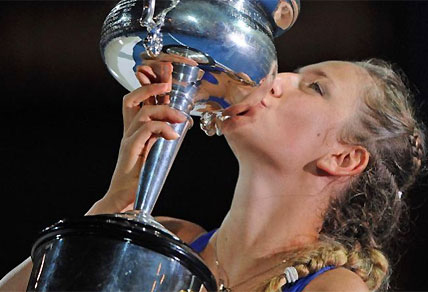For the majority of her career, approximately at its half-way stage, Sharapova has slipped and slide, criticized and dreaded playing on the red stuff, famously dubbing herself a 'cow on ice' on the surface back at the 2008 French Open. Instead, the majority of her success has largely been built around a high risk, high pace game more suited to the fast courts of London and New York where her first two major victories were secured. What a shock it then is in 2012, to perhaps be calling the red clay Sharapova 2.0's best surface, but recent results and changes to her game since her shoulder surgery may mean what would once have been considered impossible is now true.
My analysis of Maria's clay game can be broken up into the parts where the slower surface helps her game, and how by aiding Maria's strengths the surface may also reduce her opponents ability to play successfully against her.
The Sharapova return of serve has and will always be one of the most devestating aspects of her game. Her natural timing and ability to connect well with the ball on the stretch means that this will always be a strength, but the slow pace and high bounce of a clay court is perfect for this shot to thrive. Last week in Stuttgart, and particularly against Stosur and Azarenka, serves that would rush through on grass and hard courts sat up that little bit more allowing her that extra time to set up her return. Indeed in the final, she hit over 5 clean return winners, and many more unretrieveable returns based on this advantage.
In terms of movement, this has always been a tough area for the 6 ft blonde on a slippery and foreign surface to her (and will continue to be so) but she seems to have found a way to hide it. Never a great mover on any surface, the slower conditions required for clay court tennis means better movers find it tougher to keep her on the run. Despite still being an unorthodox slider, the extra time clay provides allows her to sort her feet out better than on the quicker surfaces these days, giving her more time to bludgeon a groundstroke for a winner. In these cases where Maria is afforded time to set herself up to wallop a backhand, there aren't many women who can co-exist never mind beat her from the back of the court, Serena excused.
Another improvement i found in Maria's game this week was the serve, which post shoulder surgery has really been the key piece of the jigsaw missing for her. Her first serve percentage since the quarter against Stosur never strayed under 60% and hitting it as hard as she does, that's nothing to be scoffed at. For me, the clay attitude which downplays the need to get your first serve in has actually helped Maria to loosen up and just go for it, avoiding the doubles and tension which has so often infiltrated her serve in the past 2 or 3 years.
No doubt many fans and critics alike will be tempted to jump on the Maria train straight to the Roland Garros title, but i wager that there'll be a few tests yet before she can be considered the front runner for the French.
1. Stay injury free! Sharapova has played a heavy schedule so far this season and won a lot of matches, with both Madrid and Rome still to come before the French she needs to avoid burnout and or peaking to soon.
2. Beat the tricksters! Pova's biggest match-up struggle could come from the guile and crafty skills of a Schiavone, Medina, or definately Radwanska who she lost to in Miami. If she can beat the slice of Schiavone, and rally with Aga before she gets to Paris then she'll be looking good.
3. Finally beat or avoid Serena Williams! Maria's big bogey player who she hasn't beaten since 2004 and seems to have the Russian's number, and be in her head. The form Serena showed in Charleston, she very well may have to beat the American to win the tournament and that will be her biggest challenge.
To finish, the final with Vika to demonstrate the effect clay is having on Sharapova's game this season.
Check out the super returns at 5:20 and 6:50.
Come back tommorow for my thoughts on the transition to blue clay at the upcoming Madrid Masters :)
DJT




